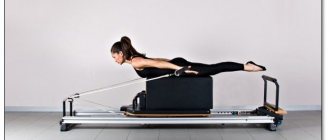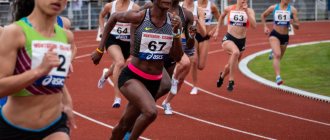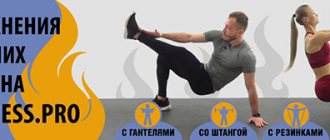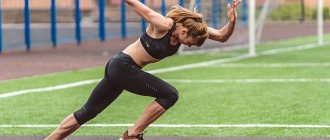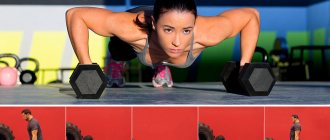How to increase physical performance is a question that concerns almost all athletes of completely different sports, from athletics and weightlifting to bodybuilding , so let's understand what endurance is and how to increase it with the help of special physical exercises, aerobic and strength training.
The ability to maintain high performance for a long time, without reducing performance, is usually called endurance.
Currently, there are two main types of endurance, power and speed . It is almost impossible to possess both types at a high level at once; rather, the athlete will be very strong for a long time, but have a low speed of movement.
All physical exercises for developing endurance can be divided into two types, general and special.
General include , first of all, running, skiing, swimming, cycling, and special exercises include those types of exercises that increase endurance in a specific, specialized exercise.
For example, hitting a punching bag for a long time increases impact endurance, working on rubber with imitation of swimming movements increases the stroke endurance of swimmers.
In addition, you need to understand that it can be divided into two more broad classes :
- aerobic
- anaerobic
If in the first case, the body is supplied with energy through carbohydrates and fats , then in the second through glycogen and creatine phosphate . Depending on the goal, the athlete develops one or another type of endurance. Those who want to be functional and not get tired for a long time when performing any active activity, we recommend developing universal, general endurance with the help of appropriate exercises.
Exercises to develop endurance
Bodymaster.ru recommends Training Plans:
During these exercises, two energy systems that peacefully coexist in our body are actively involved in the work: aerobic and anaerobic.
These systems are responsible for the production of ATP (adenosine triphosphate, which plays an important role in the process of energy metabolism). A well-developed aerobic energy system quickly converts carbohydrates into energy, and during systematic, long-term exercise, fats and proteins are also included in this process. This makes aerobic training almost ideal for losing weight and burning excess fat.
If you are interested in how to properly develop your endurance and get less tired in training and in everyday life, you are on the right track.
ATP production during aerobic exercise
Known as adenosine triphosphoric acid, ATP is involved in the release of energy. The work of ATP comes down to the fact that it provides all the cells of our body with energy, which is so necessary for metabolism and for our life in general.
Almost any process occurring inside the body cannot do without ATP, including muscle contractions.
Aerobic training and exercises to develop endurance are precisely aimed at increasing the amount of energy produced by the body. This is especially important during long-term, low-intensity exercise, such as jogging.
The benefits and dangers of anaerobic exercise
Anaerobic exercise has a number of positive effects on the human body that cannot be achieved with aerobic training:
- building muscles, building a sculpted body;
- development of endurance and strength;
- strengthening the skeletal system;
- acceleration of metabolism and increased post-workout fat burning;
- removal of toxins from the body.
However, anaerobic training is associated with a lot of risks:
- muscle congestion and general poisoning of the body with lactic acid;
- overload of the cardiovascular and other systems;
- excessive growth of aggressive oxygen molecules causing oxidative stress.
The result of anaerobic overload and insufficient recovery can be a sports disease, also known as overtraining syndrome. Not only the correct distribution of loads and rest, but also the use of sports nutrition helps to avoid this.
Aerobic endurance training
The best way to develop aerobic endurance is through general cardio exercise. These include physical activities that strengthen the heart and lungs. For example, jumping rope, jogging, walking, swimming, etc. Methods aimed at increasing aerobic endurance can be divided into three levels:
- beginning;
- average level;
- advanced.
Let's take a closer look.
Beginning
This level is intended for people who are just getting started with aerobic training. You can easily incorporate some cardio exercise into your daily routine. You just need to show a little enthusiasm in ordinary things:
- Instead of the elevator, take the stairs.
- Walk quickly to the nearest supermarket or gym. You can complicate the task a little - walk home from the supermarket with all your purchases in hand. A brisk walk will do. See how much faster your heart beats.
- Walk around the apartment at a brisk pace or even go for a run. If someone asks you to help bring something, don’t refuse.
Average level
The intermediate level is intended for more experienced athletes who have already done cardio exercises. You can start with a short aerobic workout and gradually increase its duration. For example, you started with 15-20 minutes 4 times a week. Now, over the next 2-4 weeks, increase the time to 30 minutes.
Aerobic and anaerobic endurance
Cultivating coordination abilities
Coordination is the coordination of the work of individual motor units within one muscle - intramuscular coordination;
-coordination movements. The consistency and orderliness in space and time of movements of individual parts of the athlete’s body achieved as a result of training. Ability to quickly transform movements to suit new conditions. It is achieved by a more rational inclusion of muscle groups that ensure movement performance in terms of spatial, temporal and dynamic characteristics in accordance with the structure of a specific motor skill.
-muscle coordination. Coherence in the work of several muscle groups, ensuring the execution of a particular movement. To determine the degree of coordination, various exercises of increased coordination complexity and the content of novelty elements are used. The development of coordination abilities is influenced by the development of the correct technique of natural movements.
Agility is a specific quality that manifests itself differently in different sports. A person may have a high degree of dexterity in gymnastics, but not enough for sports games. Dexterity is closely related to motor skills and is therefore the most complex. Following the generally accepted opinion, agility is, firstly, the ability to master complex motor coordination; secondly, sports movements and their improvement; thirdly, in accordance with the changing situation, quickly and rationally restructure your actions. As is known, there are several criteria of dexterity that make it possible to quantify this ability: 1. Coordination difficulty of a motor task. 2. Accuracy of execution (correspondence of spatial, temporal and power characteristics to the motor task). 3. Mastery time (training time that is required for an athlete to master the required accuracy of movement or correct it). In sports that are characterized by numerous changes in activity conditions, a large variability of actions is important to reduce; the time between the signal to perform and the start of the movement. Rapidly changing environments require great agility to respond quickly, expediently and consistently. Here, the ability to quickly adapt can serve as a measure of agility .
Another prerequisite that influences the development of agility is
the range of movements.
Each movement being studied is partially based on old, already developed coordination combinations, which together with new ones form a new skill. The more motor skills an athlete has, the easier it is to learn new forms of movement, better adapting to existing and changing conditions and the nature of the action. It subordinates the constituent elements to the main task of the action being performed and turns them into a means for accomplishing this task. It is assessed, for example, by indicators of target accuracy - the number of hits when throwing a ball into a hoop in basketball, various objects at a target, etc. Some control exercises to determine the level of coordination abilities: 1) running “snake”; 2) shuttle run 3 x 10 m; 3) shuttle run 4x9 m with sequential carrying of two cubes behind the start line; 4) throwing the ball at a target from different distances and from different starting positions.
Strength training
Strength is a person’s ability to overcome external resistance or resist it through muscular effort
(stress).
Strength abilities are a complex of various human manifestations in certain motor activities, which are based on the concept of “strength”.
A distinction is made between strength abilities themselves and their combination with other physical abilities (speed-strength, strength agility, strength endurance)
Actually, strength abilities are manifested: 1) with relatively slow muscle contractions, in exercises performed with near-maximum, maximum weights (for example, when squats with a fairly heavy weight barbell); 2) with muscle tension of the isometric (static) type (without changing the length of the muscle). In accordance with this, a distinction is made between slow strength and static strength. Strength abilities themselves are characterized by high muscle tension and are manifested in overcoming, yielding and static modes of muscle work. They are determined by the physiological diameter of the muscle and the functional capabilities of the neuromuscular system. Static strength is characterized by two of its manifestation features: 1) when muscles are tensed due to active volitional efforts of a person (active static force); 2) when external forces or under the influence of a person’s own weight try to forcibly stretch a tense muscle (passive static force).
The development of actual strength abilities can be aimed at developing maximum strength (weightlifting, kettlebell lifting, power acrobatics, track and field throwing, etc.); general strengthening of the musculoskeletal system of those involved, necessary in all sports (general strength) and body building (bodybuilding).
Speed-strength abilities are characterized by unlimited muscle tension, manifested with the necessary, often maximum power in exercises performed at a significant speed, but, as a rule, not reaching the maximum value. They manifest themselves in motor actions, in which, along with significant muscle strength, speed of movement is also required (for example, take-off in long and high jumps from a place and from a run, the final effort when throwing sports equipment, etc.). Moreover, the more significant the external burden overcome by the athlete (for example, when lifting a barbell to the chest), the greater the role the power component plays, and with less burden (for example, when throwing a javelin), the importance of the speed component increases.
Speed-strength abilities include: 1) fast strength; 2) explosive power. Fast Power
characterized by unlimited muscle tension, manifested in exercises that are performed at a significant speed that does not reach the maximum value.
Explosive strength
reflects a person’s ability to achieve maximum strength in the shortest possible time while performing a motor action (for example, with a low start in short-distance running, in athletics jumping and throwing, etc.) - Explosive strength is characterized by two components: starting strength and accelerating force Starting force is a characteristic of the ability of muscles to quickly develop working force at the initial moment of their tension. Accelerating force is the ability of muscles to quickly increase working force in conditions of their contraction.
Specific types of strength abilities include strength endurance and strength agility.
Strength endurance is the ability to withstand fatigue caused by relatively prolonged muscle strain of significant magnitude. Depending on the mode of muscle operation, static and dynamic strength endurance are distinguished. Dynamic strength endurance is typical for cyclic and acyclic activities, and static strength endurance is typical for activities associated with maintaining working tension in a certain position. For example, when resting your hands to the sides on the rings or holding your hand while shooting from a pistol, static endurance is manifested, and when repeated push-ups while lying down, squats with a barbell, the weight of which is equal to 20-50% of the maximum strength capabilities of a person, dynamic endurance is reflected.
Strength agility manifests itself where there is a changeable nature of the mode of muscle work, changing and unforeseen situations of activity (rugby, wrestling, bandy, etc.). It can be defined as “the ability to accurately differentiate muscle efforts of different magnitudes under conditions of unforeseen situations and mixed modes of muscle work”
In physical education and sports training to assess the degree of development
In terms of strength abilities, a distinction is made between absolute and relative strength.
Absolute strength
is the maximum force exerted by a person in any movement, regardless of the mass of his body.
Relative strength
is the strength exerted by a person per 1 kg of his own weight. It is expressed as the ratio of maximum strength to a person’s body weight. In motor actions where you have to move your own body, relative strength is of great importance. In movements where there is little external resistance, absolute strength does not matter; if the resistance is significant, it takes on a significant role and is associated with maximum explosive force.
Fixed assets
1.Exercises with the weight of external objects:
barbells with a set of discs of different weights, collapsible dumbbells, kettlebells, medicine balls, partner’s weight, etc.
2.Exercises weighted with your own body weight:
—exercises in which muscle tension is created due to the weight of one’s own body (hanging pull-ups, push-ups, maintaining balance while standing, hanging);
—exercises in which your own weight is aggravated by the weight of external objects (for example, special belts, cuffs);
—exercises in which your own weight is reduced through the use of additional support;
- impact exercises in which one’s own weight increases due to the inertia of a freely falling body (for example, jumping from a height of 25-70 cm or more with an immediate subsequent jumping up).
3.Exercises using general training devices
(for example, a weight bench, a power station, a “Universal” complex, etc.).
4.Jerk-braking exercises.
Their peculiarity is the rapid change of tension during the work of synergistic and antagonistic muscles during local and regional exercises with and without additional weights.
5. Static exercises in isometric mode (isometric exercises):
- in which muscle tension is created due to volitional efforts with the use of external objects (various supports, holds, support, counteraction, etc.);
—in which muscle tension is created through volitional efforts without the use of external objects in self-resistance.
Maximum Effort Method
involves performing tasks related to the need to overcome maximum resistance (for example, lifting a barbell of maximum weight). This method ensures the development of the ability to concentrate neuromuscular efforts and provides a greater increase in strength than the non-limiting effort method. It is not recommended to use it when working with beginners and children, but if there is a need to use it, then strict control over the implementation of the exercises should be ensured.
Unlimited Effort Method
involves the use of non-limiting weights with a maximum number of repetitions (until failure). Depending on the magnitude of the weight, which does not reach the maximum value, and the direction in the development of strength abilities, a strictly standardized number of repetitions is used from 5-6 to 100.
Dynamic force method.
The essence of the method is to create maximum power tension by working with unlimited weights at maximum speed. The exercise is performed with full amplitude. This method is used to develop quick strength, i.e. the ability to exert great force in conditions of rapid movements.
"Shock" method
involves performing special exercises with instantaneous overcoming of shock-impacting weights, which are aimed at increasing the power of efforts associated with the most complete mobilization of the reactive properties of muscles (for example, jumping from a height of 45-75 cm, followed by an instant jump up or long jump). After preliminary rapid stretching, a more powerful muscle contraction is observed. The magnitude of their resistance is determined by the mass of their own body and the height of the fall
Method of static (isometric) efforts.
Depending on the tasks being solved when developing strength abilities, the method involves the use of isometric stresses of varying magnitude. In the case when the task is to develop maximum muscle strength, isometric tension is used at 80-90% of the maximum for a duration of 4-6 s, 100% - 1-2 s. If the goal is to develop general strength, use isometric tension of 60-80% of the maximum for 10-12 seconds in each repetition. Typically, during training, 3-4 exercises are performed, 5-6 repetitions of each, with a 2-minute rest between exercises.
Statodynamic method.
It is characterized by a consistent combination in the exercise of two modes of muscle work - isometric and dynamic. To develop strength abilities, 2-6-second isometric exercises with an effort of 80-90% of the maximum are used, followed by dynamic work of an explosive nature with a significant reduction in weight (2-3 repetitions per set, 2-3 series, rest 2-4 minutes between series). The use of this method is advisable if it is necessary to develop special strength abilities precisely with a variable mode of muscle work in competitive exercises.
Circuit training method.
Provides a complex effect on various muscle groups. Exercises are carried out at stations and selected in such a way that each subsequent series includes a new muscle group in the work. The number of exercises affecting different muscle groups and the duration of their execution at stations depend on the tasks being solved in the training process, the age, gender and preparedness of the trainees. A set of exercises using non-limiting weights is repeated 1-3 times in a circle. The rest between each repetition of the complex should be at least 2-3 minutes, during which relaxation exercises are performed.
Game method
provides for the development of strength abilities mainly in gaming activities, where gaming situations force changes in the tension regimes of various muscle groups and fight against increasing fatigue of the body.
In the practice of physical education, quantitative strength capabilities are assessed in two ways: 1) using measuring devices - dynamometers,
dynamographs, strain gauge force measuring devices;
2) using special control exercises, strength tests. To determine the level of development of speed-strength abilities and strength endurance, the following control exercises are used: jumping rope ,
pull-ups
,
push-ups on parallel bars, from the floor or from a bench
,
lifting the body from a lying position with with bent knees
,
hanging on bent and half-bent arms, inversion lifting on a high bar, standing long jump from two legs
,
triple jump from foot to foot (option - only on the right and only on the left leg), raising and lowering straight legs to limiter, jump up with a swing without swinging your arms (the height of the jump is determined), throwing a medicine ball (1 - 3 kg) from various starting positions with two and one hands, etc.
Aerobic and anaerobic endurance
Endurance is the ability to withstand physical fatigue during muscular activity. The measure of endurance is the time during which muscular activity of a certain nature and intensity is carried out. For example, in cyclic types of physical exercise (walking, running, swimming, etc.), the minimum time to cover a given distance is measured. In gaming activities and martial arts, the time during which the level of a given efficiency of motor activity is achieved is measured. In complex coordination activities associated with precision movements (gymnastics, figure skating, etc.), an indicator of endurance is the stability of technically correct execution of the action.
There are general and special endurance. General endurance (aerobic) -
This is the ability to perform work of moderate intensity for a long time with the global functioning of the muscular system. In another way, it is also called aerobic endurance. A person who can endure long running at a moderate pace for a long time is able to perform other work at the same pace (swimming, cycling, etc.). The main components of general endurance are the capabilities of the aerobic energy supply system, functional and biomechanical economization.
General endurance plays a significant role in optimizing life activity, acts as an important component of physical health and, in turn, serves as a prerequisite for the development of special endurance.
Special endurance (anaerobic)
- this is endurance in relation to a certain motor activity. Special endurance is classified: according to the characteristics of the motor action with the help of which the motor task is solved (for example, jumping endurance); according to the signs of motor activity, under the conditions of which the motor task is solved (for example, gaming endurance); based on signs of interaction with other physical qualities (abilities) necessary for the successful solution of a motor task (for example, strength endurance, speed endurance, coordination endurance, etc.). The manifestation of endurance in various types of motor activity depends on many factors: bioenergetic, functional and biochemical economization, functional stability, personal and mental, genotype (heredity), environment, etc. The development of endurance occurs from preschool age to 30 years (and to moderate intensity loads and above). The most intensive growth is observed from 14 to 20 years.
In the practice of physical education, a wide variety of physical exercises of a cyclic and acyclic nature are used, for example, long running, cross-country running (cross), skiing, skating, cycling, swimming, games and play exercises, exercises performed using the circuit training method (including 7-8 or more exercises in a circle, performed at an average pace), etc. The main requirements for them are as follows: exercises must be performed in zones of moderate and high power work; their duration ranges from several minutes to 60-90 minutes; the work is carried out with the global functioning of the muscles.
Most types of special endurance are largely determined by the level of development of the anaerobic capabilities of the body, for which they use any exercises that include the functioning of a large group of muscles and allow them to perform work with maximum and near-maximum intensity.
An effective means of developing special endurance (speed, strength, coordination, etc.) are specially preparatory exercises that are as close as possible to competitive ones in form, structure and features of the impact on the functional systems of the body, specific competitive exercises and general preparatory means.
To increase the anaerobic capacity of the body, the following exercises are used:
1. Exercises that primarily help increase alactic anaerobic capacity. The duration of work is 10-15 s, the intensity is maximum. Exercises are used in repetition mode, in series.
2. Exercises that allow you to simultaneously improve alactic and lactate anaerobic abilities. The duration of work is 15-30 s, the intensity is 90-100% of the maximum available.
3. Exercises that help increase lactate anaerobic capacity. The duration of work is 30-60 s, the intensity is 85-90% of the maximum available.
4. Exercises that allow you to simultaneously improve alactic anaerobic and aerobic capabilities. Duration of work 1-5 minutes, intensity 85-90% of the maximum available. The main methods for developing general endurance are: 1) the method of continuous (continuous) exercise with a load of moderate and variable intensity; 2) method of repeated interval exercise; 3) circuit training method; 4) game method; 5) competitive method
To develop special endurance, the following are used: 1) methods of continuous exercise (uniform and variable); 2) methods of interval intermittent exercise (interval and repeated); 3) competitive and gaming methods.
Uniform method
characterized by continuous long-term operation with uniform speed or effort. At the same time, the student strives to maintain a given speed, rhythm, constant tempo, amount of effort, and range of movements. Exercises can be performed at low, medium and maximum intensity.
Variable method
differs from uniform by sequentially varying the load during a continuous exercise (for example, running) through a directed change in speed, tempo, range of movements, magnitude of effort, etc.
Interval method
involves performing exercises with standard and variable loads and with strictly dosed and pre-planned rest intervals. As a rule, the rest interval between exercises is 1-3 minutes (sometimes 15-30 seconds). Thus, the training effect occurs not only and not so much at the time of execution, but during the rest period. Such loads have a predominantly aerobic-anaerobic effect on the body and are effective for the development of special endurance.
Circuit training method
involves performing exercises that affect various muscle groups and functional systems, such as continuous or interval work. Typically, a circle includes 6-10 exercises (“stations”), which the student goes through 1 to 3 times.
Competitive method
involves the use of various competitions as a means of increasing the level of endurance of the student.
The gaming method involves developing endurance during the game, where there are constant changes in the situation and emotionality.
Nonspecific tests for determining endurance include: 1) running on a treadmill; 2) pedaling on a bicycle ergometer; 3) step test. During the test, both ergometric (time, volume and intensity of task completion) and physiological indicators (maximum oxygen consumption - MOC, heart rate - HR, anaerobic metabolic threshold - ANNO, etc.) are measured.
The endurance of a particular athlete depends on the level of development of his other motor qualities (for example, speed, strength, etc.). In this regard, absolute and relative indicators of endurance should be taken into account. With absolute ones, indicators of other motor qualities are not taken into account, but with relative ones, they are taken into account.
15. Strength endurance is the ability to withstand fatigue caused by relatively prolonged muscle strain of significant magnitude. Depending on the mode of muscle operation, static and dynamic strength endurance are distinguished. Dynamic strength endurance is typical for cyclic and acyclic activities, and static strength endurance is typical for activities associated with maintaining working tension in a certain position. For example, when resting your hands to the sides on the rings or holding your hand while shooting from a pistol, static endurance is manifested, and when repeated push-ups while lying down, squats with a barbell, the weight of which is equal to 20-50% of the maximum strength capabilities of a person, dynamic endurance is reflected.
METHODS: To develop special strength endurance, the following are used: 1) methods of continuous exercise (uniform and variable); 2) methods of interval intermittent exercise (interval and repeated); 3) competitive and gaming methods.
Uniform method
characterized by continuous long-term operation with uniform speed or effort. At the same time, the student strives to maintain a given speed, rhythm, constant tempo, amount of effort, and range of movements. Exercises can be performed at low, medium and maximum intensity.
Interval method
involves performing exercises with standard and variable loads and with strictly dosed and pre-planned rest intervals. As a rule, the rest interval between exercises is 1-3 minutes (sometimes 15-30 seconds). Thus, the training effect occurs not only and not so much at the time of execution, but during the rest period. Such loads have a predominantly aerobic-anaerobic effect on the body and are effective for the development of special strength endurance.
Circuit training method
involves performing exercises that affect various muscle groups and functional systems, such as continuous or interval work. Typically, a circle includes 6-10 exercises (“stations”), which the student goes through 1 to 3 times.
Competitive method
involves the use of various competitions as a means of increasing the level of endurance of the student.
Cultivating flexibility.
Flexibility is the ability to perform movements with a large amplitude. The term “flexibility” is more acceptable if we mean the total mobility in the joints of the whole body. And in relation to individual joints, it is more correct to say “mobility” rather than “flexibility”, for example “mobility in the shoulder, hip or ankle joints”. Good flexibility ensures freedom, speed and efficiency of movements, increases the path of effective application of effort when performing physical exercises. Insufficiently developed flexibility makes it difficult to coordinate human movements, as it limits the movement of individual parts of the body
According to the form of manifestation, flexibility is distinguished between active and passive.
With active flexibility
movement with a large amplitude is performed due to the own activity of the corresponding muscles.
Passive flexibility
as the ability to perform the same movements under the influence of external tensile forces: the efforts of a partner, external weights, special devices, etc.
According to the method of manifestation, flexibility is divided into dynamic
and
static.
Dynamic flexibility is manifested in movements, and static flexibility is manifested in postures. There are also general and special flexibility. General flexibility is characterized by high mobility (range of motion) in all joints (shoulder, elbow, ankle, spine, etc.); special flexibility - amplitude of movements corresponding to the technique of a specific motor action.
As a means of developing flexibility, exercises that can be performed with maximum amplitude are used. They are otherwise called stretching exercises.
The main restrictions on the range of movements are the antagonist muscles. To stretch the connective tissue of these muscles, to make the muscles pliable and elastic (like a rubber band) is the task of stretching exercises. Stretching exercises include active, passive and static ones. Active movements with full amplitude (swinging arms and legs, jerking, bending and rotating movements body) can be performed without objects and with objects (gymnastic sticks, hoops, balls, etc.).
Passive flexibility exercises include: movements performed with the help of a partner; movements performed with weights; movements performed using a rubber expander or shock absorber; passive movements using one’s own strength (pulling the body towards the legs, bending the hand with the other hand, etc.); movements performed on apparatus (the weight of one’s own body is used as a weight).
Static exercises, performed with the help of a partner, your own body weight or force, require maintaining a stationary position with maximum amplitude for a certain time (6-9 s). This is followed by relaxation and then repetition of the exercise.
Exercises to develop mobility in the joints are recommended to be carried out by actively performing movements with a gradually increasing amplitude, using springy “self-grabs”, rocking, swinging movements with a large amplitude. The main method of developing flexibility is the repeated method, where stretching exercises are performed in series. Depending on the age, gender and physical fitness of those involved, the number of repetitions of the exercise in a series is differentiated. Game and competitive methods are also used to develop and improve flexibility (who can bend lower; who, without bending their knees, can lift a flat object from the floor with both hands, etc.). Tests: Mobility in the shoulder joint.
The subject, holding the ends of a gymnastic stick (rope), twists his straight arms backwards.
The mobility of the shoulder joint is assessed by the distance between the hands when twisted: the smaller the distance, the higher the flexibility of this joint, and vice versa. In addition, the smallest distance between the hands is compared with the width of the subject’s shoulder girdle. Active abduction of straight arms upward from a position lying on the chest, arms forward. The greatest distance from the floor to the fingertips is measured.1. Mobility of the spinal column.
Determined by the degree of forward tilt of the body
.
The subject, standing on a bench (or sitting on the floor), leans forward to the limit without bending his knees.
The flexibility of the spine is assessed using a ruler or tape based on the distance in centimeters from the zero mark to the third finger of the hand. If the fingers do not reach the zero mark, then the measured distance is indicated by a minus sign (-), and if they fall below the zero mark (+). 2. “Bridge” .
The result (in cm) is measured from the heels to the fingertips of the subject.
The shorter the distance, the higher the level of flexibility, and vice versa. 3.Mobility in the hip joint.
The subject strives to spread his legs as wide as possible: 1) to the sides and 2) back and forth, leaning on his hands
.
The level of mobility in a given joint is assessed by the distance from the floor to the pelvis (tailbone): the shorter the distance, the higher the level of flexibility, and vice versa.
4.Mobility in the knee joints.
The subject performs a squat with his arms extended forward or his arms behind his head
.
A full squat indicates high mobility in these joints.
5.Mobility in the ankle joints.
Various parameters of movements in joints should be measured based on compliance with standard testing conditions: 1) identical initial positions of body links; 2) the same (standard) warm-up; 3) repeat flexibility measurements at the same time, since these conditions somehow affect mobility in the joints.
Bodymaster.ru recommends Fitness Trainers:
As soon as you feel that you are accustomed to such loads and by the end of the aerobic workout your working heart rate is the same as when you just started training (20 minutes, 4 times a week), increase the number of workouts by 1-2. That is, now you work out 5-6 times a week.
The duration and amount of aerobic training should be increased gradually, and not immediately over 2-4 weeks. For at least 2 weeks, do the same time or number of workouts. The body needs time to adapt to the increased intensity.
Advanced
The advanced level is designed to take you to a completely new level. But let's go back to anatomy for a second.
The main factor that limits the energy systems of our body is the formation of lactic acid. The same one that leads to early muscle fatigue during physical activity.
The graph clearly shows how different the level of performance of a trained and untrained person is with an increase in heart rate (heart rate).
Developing anaerobic endurance increases muscle tolerance to lactic acid release. This way, you will be less tired, which means you will have time to do more.
The right moment is coming for HIIT (from HIIT this is High-intensity interval training) exercises. High-intensity interval training significantly increases physical anaerobic endurance, provided you give 100% every time.
In short, HITT is a cardio workout that alternates periods of high-intensity sprinting (80% - 95% of maximum heart rate) and periods of low intensity - brisk walking or running (60% - 75% of maximum heart rate).
Typically, high-intensity periods are shorter to allow you to work at the highest possible speed, and low-intensity periods are longer. Here your heart rate returns to its original level, which was before the intense phase.
And then sprint again. The following daily workout programs are presented in order of increasing difficulty for the trained athlete.
How to develop?
To understand what aerobic endurance is and develop it correctly, you need to perform a whole range of different exercises, supplement your diet with special sports supplements and adhere to a certain rhythm of life. Let's consider how this or that factor affects aerobic endurance and how to develop it correctly.
| System | Effect on aerobic endurance | How to develop? |
| Lung tissue development | Increases lung volume, which increases the energy efficiency of all systems and reduces the effect of hypoxia in target muscle tissues. | Train in conditions of constant hypoxia. For this purpose, training in the form of swimming or aerobic training in a hypoxic mask is suitable. Another option would be jogging in the mountains or regular exercise in mountainous areas. |
| Development of the diaphragm muscles | Increases strength and endurance directly by creating myofibrillar hypertrophy, due to which the body adapts to the load at the original intensity, which reduces fatigue. Additionally, it increases the amount of oxygen that lung tissue can absorb in a second. | Train in conditions of constant hypoxia. Swimming, aerobic training in a hypoxic mask, jogging in the mountains or constant exercise in mountainous areas. |
| Targeted development of white fibers | Increases strength and endurance directly by creating myofibrillar hypertrophy. As a result, the body adapts to the load at its original intensity, which reduces fatigue. | Perform all exercises in an initially aerobic mode with a large number of repetitions. If intense work with anaerobic exercise is used as cardio exercise, it is necessary to increase the number of repetitions to the aerobic limit while decreasing the intensity. For example, 100 squats without weight or burpees in a time frame of up to 25-30 minutes |
| General adjustment of energy systems in the body | Increases the energy efficiency of muscle contractions, which allows you to significantly reduce the load, achieving greater endurance by increasing efficiency. | Same as in the paragraph above |
| Cardiac muscle training | Increases the energy efficiency of muscle contractions, which allows you to significantly reduce the load, achieving greater endurance by increasing efficiency. | Performing loads in an uncomfortable pulse mode, at which heart training begins. This is approximately 120-140 beats per minute, that is, 10% above the fat burning zone. To correctly calculate the load on the heart muscle, use the article about cardio loads and purchase a heart rate monitor. |
| Development of neuromuscular communication | Increases the energy efficiency of muscle contractions. This allows you to significantly reduce the load, achieving greater endurance by increasing efficiency. | Constant and monotonous performance of the same actions, thanks to which the body increases the number of neural connections in the brain/spinal cord/target muscle group. |
| Improving vascular elasticity | Increases the amount of oxygen in the blood due to greater pumping of target muscle groups without additional oxidation. The result is increased susceptibility and increased peak intensity at which aerobic activity becomes anaerobic. | Taking special sports supplements, multivitamins and minerals that are responsible for the elasticity of blood vessels. |
| Increased creatine phosphate in the blood | Increases the susceptibility of white muscle tissue to oxygen starvation. Creatine phosphate allows you to painlessly perform triglyceride breakdown of adipose tissue with increased pumping in a specific target group of muscle tissue. | Taking special sports supplements based on this amino acid in combination with fast grape carbohydrates. |
Development of a HIIT schedule
If you want to develop your own high-intensity interval training schedule, here are a few things to consider.
- First of all, training is no more than 20-30 minutes. If you feel like you can do more, it means you haven't worked hard enough.
- Second, warming up before and stretching after is extremely important. High intensity increases the risk of joint injury. Therefore, before training it is necessary to warm them up well.
High-intensity periods should last 30-120 seconds, and your heart rate should be between 85% of your maximum. And periods of low intensity are 60-75% of mHR (75% is the maximum in the low-intensity phase). In addition, the ratio of easy running: sprinting should ideally be 2:1.
This means 2 minutes of easy jogging and 1 minute of sprinting. To complicate the task, change the ratio, for example, 3:2 or even 1:1. For beginners, you can increase your rest time using a 3:1 ratio. The remaining periods give the body time to get rid of accumulated lactic acid, which causes fatigue during physical activity.
- Finally, do HIIT on weekends when you are not training at the gym; and, depending on your goals, do high-intensity training 2-3 times a week. Allow recovery days to avoid overtraining.
If you feel good with your chosen training frequency, you can increase the number of training sessions.
In addition, the frequency of HIIT should be planned so that you have one day of rest before and after strength training on the lower body. People with heavier builds or those with knee problems may want to work slower. For beginners, you can sprint at 75% of your maximum heart rate, and light jogging at 60%. Remember, sprints are bad for your knee joints.
Let's move on from general advice to how to combine strength training, cardio, and stretching to create a workout that develops aerobic endurance.
Based on the workouts above, we offer you a 9-week aerobic training program that consists of strength training and the methods listed earlier. Here the focus is on the cardio and intensive training parts.
Tips: how to properly develop endurance
We each have our own ideals, principles and goals in sports, some want to become strong, some want to be fast , and some do both. Of course, if you want, you can reach a certain training level when you will show for a long time strength, while at the same time possessing the qualities of a runner, but this level will be objectively low among professional athletes.
Therefore, it is necessary, first of all, to set priorities , and decide in which direction you will work, in strength or speed mode, of course you can combine everything, but this will be general physical training , and nothing more, otherwise, you will simply overtrain , and do not achieve the desired result, either in strength or speed endurance.
Cardiovascular training
- The basic principle of developing endurance is based on personal qualities, such as determination, perseverance, perseverance, because not everyone can endure muscle pain and general fatigue of the body for quite a long time, and this is the key to success, to achieving high endurance and fitness athlete
- If you are a beginner and want to become a little more resilient than you currently are, then you just need to spend more time running, swimming, and other aerobic activities. An important point is the gradual , smooth increase in load.
- Don’t try, pull as hard as you can, don’t stop doing the exercise, don’t skip classes, and then over time the body will readjust and adapt more and more to heavy loads, and as a result, your endurance will increase.
- All training programs in the gym, cross-country races at stadiums in order to increase endurance, swims in the pool, all kinds of jogging, jumping, climbing, can lead to zero results, and even worse, loss of your former physical shape, if you do not fully restore the body’s strength. stress in your life , with this approach to the training process there will be no increase in endurance, this is a rule that always works for a person, in absolutely any sport (that is why, for example, Ultimate fighting athletes often go to the mountains , where there is clean air, silence, lack of stress, good nutrition, so the athlete concentrates entirely on the training process)
- It is very important to monitor your heart rate, which should not exceed about 85% of the maximum possible (it is usually determined by simple calculations - your age is subtracted from 220 ). As a rule, endurance training in the range of 20-25 blows in 10 seconds has a healing effect on the body. Frequent training at maximum heart rate has a detrimental effect on the heart, acidifying it with lactic acid, resulting in myocardial dystrophy , destruction and death of muscle cells, which is why professional sports, which imply stress at the limit of the body’s capabilities, has nothing to do with health .
Sports supplements, adequate sleep, healthy nutrition , properly designed training to increase the functional abilities of the body, these are the factors that affect the recovery of an athlete. If even one factor is missing, the training goes down the drain, so never neglect them.
Correctly increasing your endurance means increasing your health and reducing the load on your heart . Therefore, if you are not a professional athlete whose performance is off the charts, don’t sit idly by, start taking action , sign up for a sports section, or start training at home.
If you find an error, please select a piece of text and press Ctrl+Enter.
Aerobic endurance training program
| A week | Day | Training |
| 1 | Mon | Cardio 70% of maximum heart rate for a 20 minute morning workout. In the evening – strength training (upper body, chest, deltoids). |
| W | HIIT for 20 minutes (for example, the first workout option) | |
| Wed | Rest | |
| Thu | Evening strength training for the lower body | |
| Fri | Cardio 70% of maximum heart rate for a 20 minute morning workout. | |
| Sat | HIIT for 20 minutes (for example, the first workout option) | |
| Sun | Cardio 70% of maximum heart rate for a 20 minute morning workout. In the evening – strength training (upper body, chest, deltoids). | |
| 2 week | Same as the first week. | |
| 3 week | Increasing the duration of cardio training to 30 minutes. | |
| 4 week | Same as week three. | |
| 5 week | Change the HIIT workout, for example, from option 1 to option 2. | |
| week 6 | Same as week 5. | |
| week 7 | Increasing the duration of cardio training to 45 minutes. | |
| 8 week | Change the HIIT workout, for example, from option 2 to option 3. | |
| Week 9 | Time to reduce the load. Reduce the time of your morning cardio session from 45 to 30 minutes. Reduce the number of strength training sessions from 3 to 2. | |
Stretching should be done before and after exercise, as well as after strength training. Stretching before training increases blood flow to the muscles, warms them up and prepares them for intense work.
Nutrition and supplements
Health and general tone of the body requires careful treatment and constant support: an active lifestyle, proper nutrition and taking special supplements - vitamin-mineral complexes, omega-3, antioxidants and glutamine for joints and ligaments. These drugs contain elements necessary for the proper functioning of your body during intense training.
| Beta-alanine | Helps stabilize muscle acidity, which prevents the accumulation of lactic acid in the muscles and leads to an overall increase in muscle performance. |
| Pre-workout complex | Increases productivity during sports, strength, endurance, recovery speed between approaches. |
| Vitamin-mineral complex | During intense physical activity, vitamins and minerals are consumed by the body faster. They are also responsible for protein synthesis and are the engine of metabolic processes. |
| Isotonic | Replenishes fluid and microelements during physical activity. Brings the water-salt balance to the physiological norm. |
| BCAAs | Allows muscle fibers to recover faster and provides building material for the growth of lean muscle mass. |
Supplements for Endurance Training
Olimp Sport Nutrition | Beta Alanine Xplode?
- Contains a matrix of additional ingredients that allow you to quickly and without loss overcome the gastric barrier and getting directly into the muscles, it does not turn into a by-product in the human body and does not overload the liver.
- Category: Amino Acid Complex More about the category
Recommendations for use: one serving before training. Recommendations for preparation: depending on body weight: up to 70 kg - dissolve 3 g in 80 ml of cold water. 70-85kg - dissolve 6 g in 160 ml of cold water. Over 85 kg - dissolve 9 g in 240 ml of cold water.
The advantage of Olimp Sport Nutrition “Beta Alanine Xplode” is that it is presented in powder form. This way you can choose the correct portion size depending on your body weight.
Olimp Sport Nutrition | Knockout 2.0?
- New formula for an excellent pre-workout complex. Benefits: 2g beta-alanine and 1g el-arginine for impact training!
- Category: Pre-workout supplements
Take one serving (6.1 g of powder or ½ scoop) 30 minutes before training mixed with 250 ml of water
Ingredients: L-citrulline, beta-alanine, citric acid, L-arginine hydrochloride, taurine, L-tyrosine, silicon dioxide, flavors, caffeine, guarana seeds, barley extract, acesulfame K, sucralose, sodium cyclamate, cayenne pepper seed extract , black pepper seed extract, ramus serrata leaf extract, carotene, carmine, riboflavin, E150c, E150d, E133, indigo, chlorophyll and chlorophyllin, curcumin, anthocyanin, paprika extract, betanin, plant carbon.
Weider | Multi Vita+ ?
- Contains an expanded amount of vitamins in the amount necessary for active sports.
- Category: Vitamin-mineral complex More about the category
Take one capsule with breakfast with water.
Vitamin C ensures the functioning of the immune system, which fights pathogens. It stimulates the production of hormones, neuropeptides and nerve impulse transmitters that improve nervous and mental activity. In addition, vitamin C strengthens connective tissue and blood vessel walls. Vitamin E performs a protective function; it neutralizes free radicals that destroy beneficial fatty acids and ensures oxygen respiration of cells, prevents inflammatory processes and has a beneficial effect on sexual function, and rejuvenates the body. Vitamin B1 strengthens the nervous system by providing nerve cells with glucose. Vitamin B2 is involved in carbohydrate, protein and fat metabolism, cellular respiration, improves vision, skin and nail structure. Pantothenic acid (vitamin B3) prevents aging, the appearance of wrinkles, helps overcome stress and fights inflammatory processes, is involved in the synthesis of skin and mucous membranes, and hair growth. Vitamin B6 plays an important role in the synthesis of antibodies of the immune system and is involved in amino acid metabolism during the construction of proteins. Vitamin B12 triggers the synthesis of DNA and RNA, is necessary for the formation of bones, and revitalizes iron reserves in the body. Niacin is involved in the formation of hundreds of different enzymes involved in the production of gastric juice, heart function, and cholesterol control. Folic acid is the main active ingredient in the production of hemoglobin and nucleic acids; it synthesizes serotonin and norepinephrine - hormones of joy that elevate mood.
Olimp Sport Nutrition | ISO Plus Powder?
- Concentrate for preparing an isotonic drink in powder, with the addition of L-carnitine and L-glutamine. Thanks to this combination, the product will help support your body during prolonged physical activity.
- Category: Isotonic drinks
Directions for Use: Use as needed, especially during intense physical activity. Recommendations for preparation: 17.5 g of powder (2 tablespoons) in 250 ml of water.
Ingredients: sugar, maltodextrins, glucose, fructose, acidity regulator, sodium chloride, potassium phosphate, calcium phosphate, sodium citrate, magnesium carbonate, thickener, flavorings, L-glutamine, L-carnitine, vitamins, flavoring.
USPLabs | Modern BCAA+ ?
- 8:1:1 Formula. USPlabs Modern BCAA is an amino acid ratio of Leucine-Isoleucine-Valine 8-1-1
- Category: BCAA More about the category
mix 2 scoops per 350-400 ml of water or other drink and take 30 minutes before and immediately after training
Why is there so much leucine? The reason is that leucine plays a key role in increasing the concentration of mTOR and, therefore, the concentration of this amino acid should be at the highest possible level.
Sports nutrition recommendations are indicative only. Before purchasing, we recommend that you consult with a specialist in the store.


